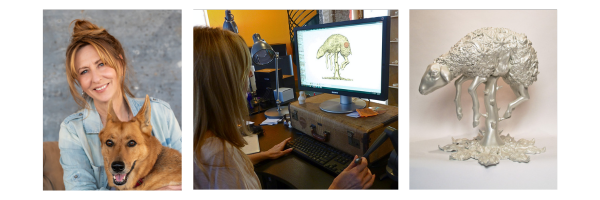The Artist and the Implants

At MedCAD, we consider our patient-matched medical devices to be works of art. That’s not just marketing copy — it’s a big part of our history, and it’s instrumental to our design process.
One of the people who works with surgeons to craft our products is Heather Gorham. Aside from all the wonderful, life-changing work she does creating pieces that disappear into working human bodies, she creates works of art that are on display in museums and galleries. Quite a bit of her work is sculptural — and much of that is 3D printed on the same machines that produce our medical devices. Many of her works can be seen at her website.
Heather has been showing her artwork for more than 30 years, and during that time she got to know another Dallas artist named Nancy Hairston. Well before Nancy became founder and CEO of MedCAD, she started a 3D design company, and asked Heather if she’d like to learn digital art.
“My first reaction was, ‘Oh, no, no, no, no, no,’ because I was used to working in bronze and wood and very tactile mediums,” says Heather. But she was amazed by the quality of the interface. “There’s haptic feedback, so you can actually feel what you’re working,” she says. “It’s not just numbers. It’s very organic for a computer system. It’s mind-blowing actually.”
“It took several years to embrace it terms my own art, to realize that it was just another tool in the toolbox.” she says. “We were being sponsored by some of the bigger printer companies to create fine art using their printers, and once we had the support and the openness to create whatever we wanted, it was easy to start envisioning.”
Her work on fine art and sculptural housewares in that first foray in 3D design eventually expanded into medical modeling — “the kind of models you would see in a doctor’s office” — though still approached the artistic side of things. But the skills she developed translated directly into the field of patient-matched implants, and when MedCAD launched, she put that experience to work.
“I mean, the basics of this are something a biomedical engineer can do, but our approach is a little less mechanical and more artistic,” says Heather. “We really take aesthetics into account, and we want what the patient wants — for the end result to look good.”
“The skull is very sculptural, and every skull is just subtly different”
Today, she works with a team that’s a mix of artists and biomedical engineers and technologists, and they work with surgeons to custom create pieces for the skull. “We have a variety of people working, so it’s a really nice mix of experiences,” she says. “We do have people that have an art background, and the skull is very sculptural, and every skull is just subtly different.”
Doing all that life-changing work hasn’t dampened her artistic life. “I’ve always worked part time at MedCAD, so I’ve always been able to balance the fine art and the digital design really nicely,” she says. “This is certainly not somewhere I ever would have envisioned myself with my background, but I truly love that I’m using art skills to actually help people improve quality of life every day.”
